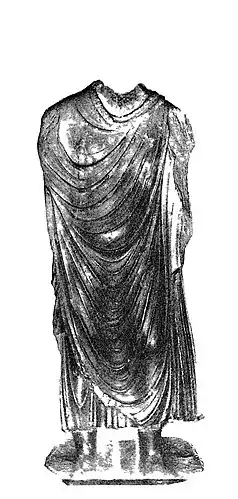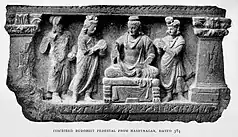Hashtnagar
Hashtnagar (Pashto: هشتنګر) (in Sanskrit अष्टनगरम्: aṣṭanagaram and more commonly known as اشنغر ashnaghar in Pashto)[3] is one of the two constituent parts of Charsadda District in Khyber Pakhtunkhwa, the name Hashtnagar is derived from Sanskrit अष्टनगरम् aṣṭanagaram, n., "The eight towns" from Sanskrit aṣṭa, num. card., "Eight" and नगर nagara, n., "settlement, locality, town". There was an unrelated town of the same name near Kabul in 17th century. It was the home to the Roshani Movement which gave rise to the modern Pashtun identity. The descriptive later being influenced by the Pashto asht, num., "eight". The etymology "Eight Towns", refers to the eight major settlements situated in this region.[4] These are:
- Chārsadda, Hashtnagar [Muhammadzai and Kheshgi]
- Prang (the 1812 list groups Prang with Chārsadda)
- Rajjar, Chārsadda
- Sherpao, Chārsadda
- Tangi, Chārsadda
- Turangzai, Chārsadda
- Umarzai, Chārsadda
- Utmanzai, Chārsadda
- Dargai, Chārsadda

History
Buddhist period
Hashtnagar is known for an early Buddhist statue. The Original name of Hashtnagar was "Ashtanagaram", "Ashta" means Eight in Sanskrit and "Nagaram" meaning "Town".[5]
Modern era
In 1812 the Asiatick Society (Calcutta, India) described the Gujars of Afghanistan as brave, mainly pastoral, and numerous in Hashtnagar district. The Muhammadzai (Charsadda) and Kheshgi were also mentioned as powerful tribes in the area.[6]
Class struggle
Hashtnagar is known for its militant socialist struggle of peasants led by the Mazdoor Kisan Party which has resulted in various positive developments of the area. Before the peasant's movement poor people were living in a suffocated and suppressed environment. They were dependent on landlords for their daily routine life, they even cannot style or comb their hairs or wear neat and tidy clothes, because it was prohibited by landlords. Violation of the rules imposed by landlords leads to severe punishment and fines.
Media
A documentary, exploring the political and cultural life of Hashtnagar, has been made by Ammar Aziz [7][8] which is the first ever film on the subject .[9] It features the local artists and political activists and romanticizes the communist movement of the area.
Notable people
See also
References
- Problems of Chronology in Gandharan Art p.37
- Errington, Elizabeth. Numismatic evidence for dating the Buddhist remains of Gandhara. p. 204.
- Raverty, Henry George (1867), A dictionary of the Puk'hto, Pus'hto, or language of the Afghans (2 ed.), Williams and Norgate, p. 33
- Asiatick Society (Calcutta; India) (1812). Asiatick researches, or, Transactions of the society instituted in Bengal, for inquiring into the history and antiquities, the arts, sciences, and literature of Asia. John Murray. pp. 383–. Retrieved 1 April 2011.
- Hendrik Willem Obbink. Orientalia Rheno-traiectina. Brill Archive. pp. 115–. GGKEY:S6C77GP5KP7. Retrieved 1 April 2011.
- Asiatick Society (Calcutta, India) (1812). Asiatick researches, or, Transactions of the society instituted in Bengal, for inquiring into the history and antiquities. John Murray.
- http://tribune.com.pk/story/331394/in-the-spotlight-screening-of-hashtnagar/
- "Documentary on insurgency survivors wins first prize". 2011-01-28. Archived from the original on 2014-05-04. Retrieved 2013-01-15.
- "A man with a movie camera in Hashtnagar!". Viewpointonline.net. 2011-03-18. Retrieved 2013-01-15.

